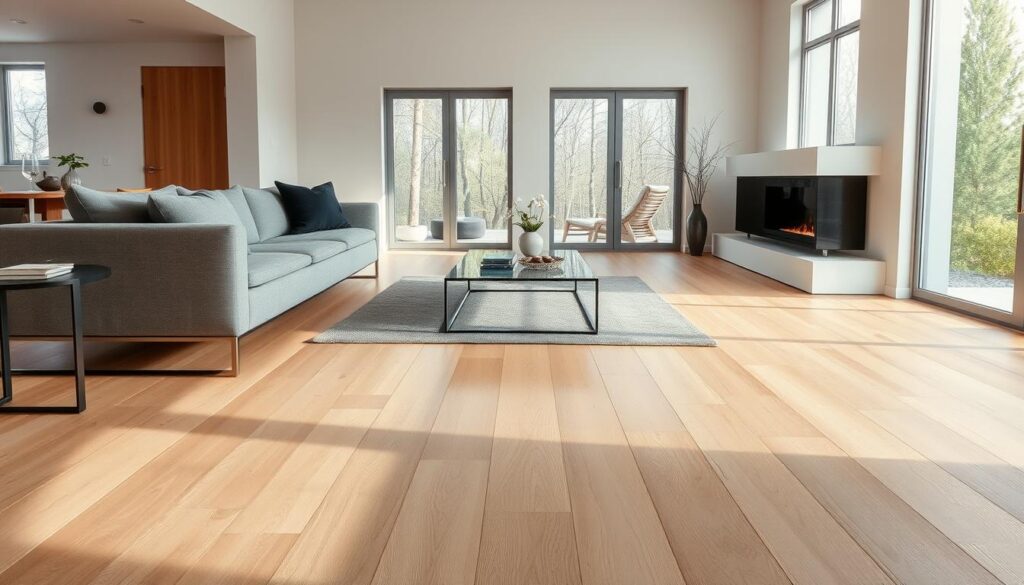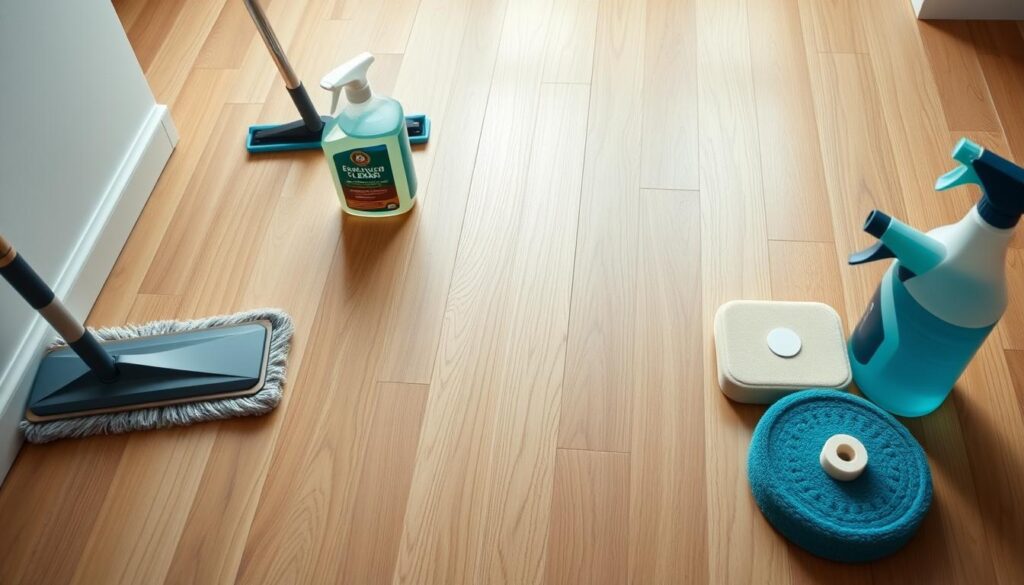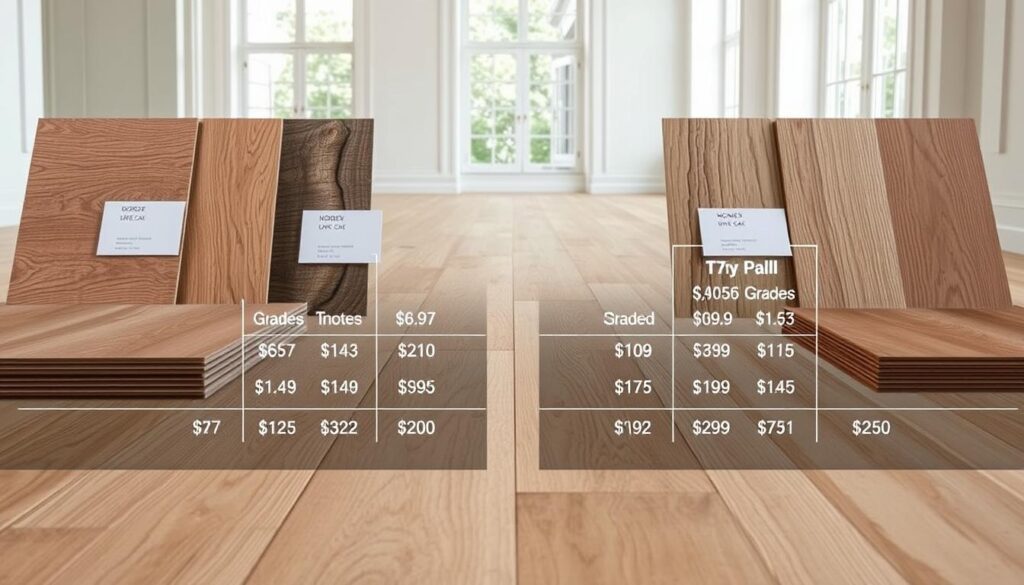Explore the beauty and durability of European white oak engineered flooring. Our listicle highlights top options to elevate your home.
European white oak engineered flooring brings together the beauty of natural wood and modern construction. It’s known for its strength and timeless look. These floors are perfect for both modern and traditional homes.
They work well in many settings, from sleek, contemporary rooms to cozy, traditional areas. White oak floors are also great because they resist scratches and moisture damage.

Key Takeaways
- European white oak engineered flooring combines elegance and resilience.
- Premium engineered flooring options offer diverse color choices like natural, whitewashed, and honey tones.
- These floors maintain value over decades, backed by warranties against wear and environmental shifts.
- Installation flexibility allows use in multiple rooms, from high-traffic areas to formal living spaces.
- They reduce long-term costs compared to lower-quality flooring alternatives.
The Timeless Appeal of European White Oak Engineered Flooring
European white oak engineered flooring is a top pick for homes. It mixes natural beauty with modern needs. This makes it perfect for today’s living spaces.
What Sets European Oak Apart
European white oak stands out with its european oak characteristics. It has dense grain patterns and even colors. Its Janka hardness rating of 1360 lbf beats other woods, showing it’s both strong and stylish.
The grain is straight and consistent. This makes it great for both modern and classic designs.
The Engineering Behind the Beauty
- Multi-ply construction uses a cross-layered plywood core for dimensional stability
- Wear layers range from 2mm to 6mm, allowing 2-5 refinishes over decades
- Hydrophobic surface treatments resist moisture better than solid hardwood
This flooring is different from engineered vs solid hardwood. It handles humidity changes well, without warping. The top layer looks like real oak, while the base is strong for busy areas.
Historical Significance in Interior Design
“European white oak’s legacy spans centuries, from medieval cathedrals to today’s minimalist lofts.”
The benefits of white oak flooring go beyond being durable. It’s been in historic places like cathedrals and palaces. Now, it brings old-world charm to modern homes.
Its history connects old craftsmanship with today’s design. This makes it a favorite among architects and designers everywhere.
Top Premium European White Oak Collections Worth Considering
When looking for the best white oak flooring, people want both beauty and strength. Here are some top luxury engineered flooring collections. They are made to make both modern and traditional spaces look great.
Video source from Youtube
| Brand | Collection Name | Key Features | Ideal Use |
|---|---|---|---|
| Anderson Douglas | Classic White Oak | 7″ planks, 6mm wear layer, UV oil finish, wire-brushed surface | Modern lofts or minimalist kitchens |
| Teragren | EcoCraft Collection | 8″ planks, 5mm wear, hand-scraped texture, polyurethane finish | Traditional homes with heavy foot traffic |
| Forstner Flooring | Urban Heritage | 5″ planks, 4mm+ wear layer, smooth surface, golden honey tones | Rustic cabins or farmhouses |
| Floorte | Signature Series | 10″ planks, 6mm wear, whitewashed finish, hand-scraped details | Open-concept living areas |
| EcoTimber | Heritage Oak | 7″ planks, 5mm core, smooth surface, golden hues | Transitional style living rooms |
These top-rated oak floors use the latest technology, like waterproof cores. They come in plank widths from 5″ to 10″. This fits different room sizes. Finishes like UV oil or hard wax oil make them last longer.
It’s important to choose the right plank size for your room. Wider planks look great in big rooms, while narrower ones fit smaller spaces better.
Color Variations That Transform Living Spaces
Choosing the right white oak floor colors can change a room’s feel. European white oak’s natural texture fits well with modern finishes. Each option adds its own charm.
Natural and Unfinished Options
Unfinished planks show oak’s original grain. Homeowners can stain them or keep them raw. These options are great for minimalist or rustic looks. They offer a blank canvas:
- Pair with muted greens or sandy neutrals for organic harmony
- Combine with industrial metal fixtures or woven textiles
Whitewashed and Bleached Varieties
Bleached oak flooring uses a light wash to highlight wood texture. It softens tones, creating bright, open spaces. Ideal for coastal or loft-style rooms. For longevity:
- Pair with linen upholstery and white trim
- Use in sunlit areas to enhance their airy feel
Rich Honey and Golden Tones
Warm golden hues add coziness to traditional spaces. These tones fit well with farmhouse or classic interiors. The honey tones resist fading under standard lighting:
- Pair with cream walls and leather accents
- Enhance with bronze fixtures and patterned rugs
Smoked and Gray-Toned Selections
Gray oak engineered floors have deep, modern shades. These durable finishes suit industrial or contemporary homes. Their muted tones work with bold accents:
- Pair with black accents and marble surfaces
- Balance with light walls to avoid overwhelming small spaces
Durability Features That Make European Oak Engineered Flooring a Smart Investment
European white oak engineered flooring is known for its long life. It has a engineered flooring durability thanks to its layered design. This design is strong yet flexible, perfect for busy areas.
Wear Layer Thickness Comparison
The thickness of the wear layer affects how long it lasts and how many times it can be refinished. Here’s a comparison:
- 2mm: It’s affordable and good for light use. You can refinish it 10–15 years later.
- 4mm: It’s a mid-range choice for areas with moderate traffic. You can refinish it 2–3 times over 20+ years.
- 6mm: It’s the best white oak hardness for heavy use. It can last 30+ years with little upkeep.
Resistance to Environmental Changes
European white oak naturally stays stable, even with humidity changes between 35–55%. Its engineered planks have layers that help it handle moisture better than solid wood. In fact, it’s 40% better at resisting moisture-related stress (per NWFA 2023 standards).
Expected Lifespan with Proper Care
Top-quality long-lasting wood floors can last 50–100 years with the right care. Here’s how to keep them looking great:
- Clean it every year to avoid scratches from grit.
- Refinish 4mm/6mm planks every 10 years to keep them shiny in busy spots.
With proper care, 6mm floors keep 85% of their value for 30 years. They last longer than laminate and bamboo by 3 times, according to studies.
Installation Methods and Best Practices
Installing engineered oak floors needs careful planning for them to last long. There are three main ways to do it: floating, glue-down, and nail-down. Each method has its own benefits and challenges.
Floating floors are great for DIY projects. They use a click-lock system, which makes them easy to install and remove. Glue-down floors are strong and good for busy areas. They stick to the subfloor with special adhesives. Nail-down floors are best for concrete, held in place with fasteners.
- Floating Floor vs Glue Down: Floating floors are less likely to get damaged by moisture but might move a bit. Glue-down floors are very stable but need to be applied carefully to avoid mess.
- Subfloor Prep: Make sure the subfloor is clean, dry, and even. Use underlayment with foam or cork to help with sound and climate.
- Expansion Gaps: Keep 3/8-inch gaps at walls and around obstacles. This lets the wood move naturally without buckling.
DIY installation works well for floating floors but is riskier for glue-down or nail-down. Hiring a pro costs $3–$10 per square foot, depending on where you are and the method used. Make sure the flooring can handle radiant heat under 85°F. Let the flooring acclimate in the room for 48–72 hours before installing.
Check the planks are aligned within 1/16-inch. Don’t nail too close to the edges to avoid warping. For glue-down, use a notched trowel to spread the adhesive right. Always test the adhesive with the subfloor first.
Maintenance Tips to Preserve Your European Oak Flooring Beauty

Regular white oak floor maintenance keeps your engineered flooring looking great. Start with daily care: sweep or use a microfiber mop to remove dust. Avoid steam mops or cleaners with ammonia, as they can damage the wood.
For cleaning engineered wood floors, use pH-neutral solutions like Bona Hardwood Floor Cleaner or Method’s Wood Floor Cleaner. Clean spills right away to prevent moisture damage.
Daily Cleaning Recommendations
- Use a soft-bristled broom or dust mop for debris
- Spot treat stains with a damp cloth and mild cleaner
- Avoid water pooling—dry floors thoroughly
Seasonal Care Requirements
Keep indoor humidity between 35–50% all year. Use humidifiers in dry winters and dehumidifiers in humid summers. Check humidity levels with a hygrometer. Make sure the floor has space to expand and contract by keeping it 6–8 inches from radiators or AC units.
Addressing Scratches and Damage
Fixing minor repairing scratched oak floors starts with touch-up pens (Minwax or Varathane) for light scuffs. For deeper scratches, use wood filler sticks. If damage is severe, get professional help for spot refinishing.
Prevent scratches by placing felt pads under furniture and trimming pet nails regularly.
Design Inspirations: How to Style Rooms with European White Oak Floors
European white oak flooring fits any style. It works well in modern spaces and cozy rustic areas. Let’s see how to use it in three popular styles.
Contemporary Minimalist Spaces
Match white oak floor design ideas with simple designs and soft colors. Choose bleached or matte-finished planks for a calm look. Wide, light planks make rooms feel bigger.
Add texture with rugs or unique lights. This brings depth to your space.
Traditional and Transitional Homes
Combine old charm with new touches using medium-toned modern oak flooring. Mix ornate details with smooth finishes. For older homes, pick planks that match the woodwork.
Blend classic decor with mid-century pieces. This creates a timeless look.
Rustic and Farmhouse Aesthetics
Make rustic decor pop with reclaimed or wire-brushed planks. Farmhouse style wood floors look great with natural flaws. Pair them with whitewashed furniture and distressed pieces.
Use warm neutrals on walls and thick textiles. This completes the rustic feel.
Cost Considerations and Value Analysis for European White Oak Engineered Options
Understanding white oak flooring cost begins with price levels. The cheapest options ($4–7/sq ft) have thinner wear layers. Mid-range ($7–12/sq ft) includes 6mm wear layers, and the most expensive ($12+/sq ft) has 8mm+ layers and fancy finishes. These prices show the difference in durability and finish quality.
- Entry-level: Basic 3–5mm wear layers
- Premium: 8mm wear layers + UV finishes

When planning, remember to include installation costs. Hiring professionals adds $3–7/sq ft, and materials like underlayment and adhesive cost $1–3/sq ft. Compare these to solid hardwood ($5–15/sq ft installed) or luxury vinyl tile ($2–8/sq ft). European engineered oak can last 25+ years with the right care.
“Oak flooring ROI averages 70–80% in resale scenarios, outperforming laminate and carpet.” — National Association of Home Builders
Placing premium engineered wood floor pricing in living areas can save money. Use cheaper options in less seen areas. Oak floors cost 10–15% less to maintain than carpet each year. Choosing quality in busy spots ensures oak flooring ROI through lasting beauty and durability.
Conclusion: Why European White Oak Engineered Flooring Continues to Be a Designer Favorite
European white oak engineered flooring is a favorite among interior designers. It combines elegance with practicality. Its layered construction makes it stable in different climates, making it a top choice.
This material fits well in modern, rustic, or traditional spaces. It’s a key part of interior designer favorites. The engineered design also supports sustainability, using less oak than solid planks but keeping strength.
Designers love its timeless look and low maintenance needs. With proper care, these floors stay beautiful for years. They resist scratches and wear better than many others.
FSC-certified options show their role in sustainable wood flooring. They match eco-conscious trends. Showrooms and design magazines often feature them, showing their lasting popularity in high-end projects.
However, they might not be best for spaces with frequent flooding or tight budgets. For those looking for a mix of style and durability, European white oak engineered flooring is a good choice. It adapts to design trends, making it a reliable choice for homes that value both looks and function.
FAQ
What are the benefits of European white oak engineered flooring compared to traditional hardwood flooring?
European white oak engineered flooring is more stable. It’s less likely to warp or expand with humidity changes. Its multi-layer design uses wood efficiently and looks like solid hardwood. With the right care, it can last for decades, saving you money in the long run.
How do I maintain European white oak engineered flooring?
Clean your floor daily with a microfiber mop and pH-neutral cleaner. Avoid steam cleaning and products with ammonia. Keep humidity between 30-50% to prevent damage. For small scratches, use a fill stick. For bigger damage, consider professional refinishing.
What installation methods are recommended for European white oak engineered flooring?
You can install it using floating floor systems, glue-down, or nail-down methods. Floating systems are easy for DIYers, while glue-down is more permanent. Make sure to follow the manufacturer’s instructions and leave expansion gaps to avoid problems.
How does the wear layer thickness affect the longevity of engineered flooring?
The thickness of the wear layer greatly affects how long the floor lasts. Wear layers range from 2mm to 6mm. Thicker layers mean more refinishing options. A 4mm+ wear layer is best for busy areas, as it can handle more wear without showing damage.
What color variations are available for European white oak engineered flooring?
You can find European white oak engineered flooring in many colors. Options include natural, whitewashed, bleached, rich honey, and smoked gray. Each color can change the feel of a room, helping you match your decor.
Is European white oak engineered flooring environmentally friendly?
Yes, many European oak engineered flooring options are eco-friendly. Look for FSC certification to ensure it comes from responsibly managed forests. The engineered design also reduces waste, making it better for the environment.
What should I consider when budgeting for European white oak engineered flooring?
When budgeting, consider the flooring cost, which is $4 to $20+ per square foot. Add extra for underlayment, adhesives, and professional installation. This investment can increase your home’s value and appeal.
How does the historical significance of European white oak influence its use in modern homes?
European white oak has been prized for centuries in architecture and furniture. Its long history adds character to modern homes. It suggests durability and value, making it a favorite among architects and homeowners.
Read also : Unbeatable Clearance Vinyl Tile Finds: Transform Your Space
